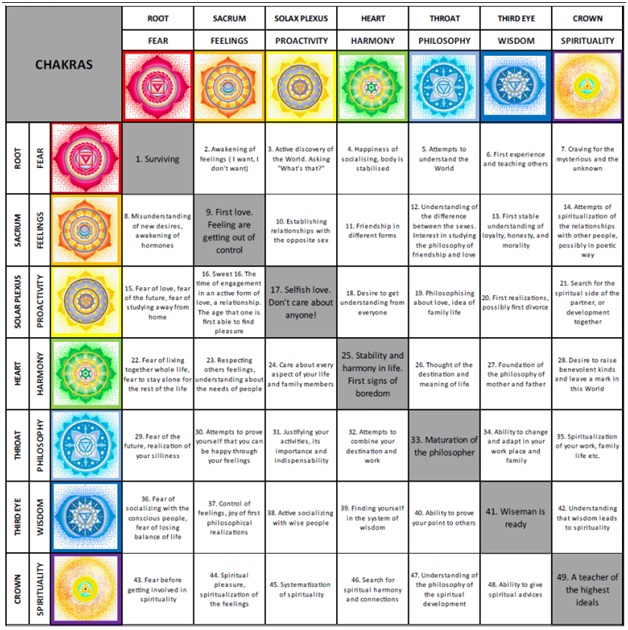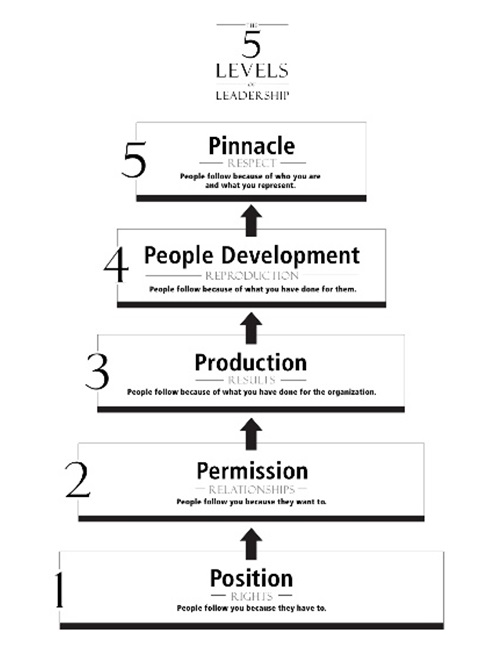Appendix 1
 How to Use the CHAKRA Chart (Suresh, 2012)
How to Use the CHAKRA Chart (Suresh, 2012)
Our life moves in 7 year cycles corresponding with each of the 7 chakra centers located in our light body. We have one dominant chakra for each cycle, corresponding to each row of the table. In the first 7 years of life (age 1-7) we are influenced by the root chakra, from ages 8-14; the sacral chakra, from 15-21; the solar plexus, and so on and so forth.
Within these 7 year cycles we also climb another 7-chakra ladder (corresponding to the top row of chakras on our table and the columns they represent) which takes us from The Root chakra to the Crown Chakra. These influences affect us (ideally) on a yearly basis. Every cycle begins with fear (the root chakra) and every cycle ends with spirituality (the crown chakra).
After completing a 7 year cycle, we enter the first stage of our second year cycle. This is our Crisis Year since the first year of a new cycle is under the influence of the Root Chakra: Fear.
Another noteworthy occasion is when we are under the influence of 2 of the same chakra centers – this is indicated by the gray boxes in the table. These are the years that that particular chakra is most dominant in your life.
Appendix 2
Maslow: Some of the characteristics of self-actualized people (McLeod, 2007)
By studying 18 people he considered to be self-actualized (including Abraham Lincoln and Albert Einstein) Maslow identified 15 characteristics of a self-actualized person.
Characteristics of self-actualizers:
- They perceive reality efficiently and can tolerate uncertainty;
- Accept themselves and others for what they are;
- Spontaneous in thought and action;
- Problem-centered (not self-centered);
- Unusual sense of humor;
- Able to look at life objectively;
- Highly creative;
- Resistant to enculturation, but not purposely unconventional;
- Concerned for the welfare of humanity;
- Capable of deep appreciation of basic life-experience;
- Establish deep satisfying interpersonal relationships with a few people;
- Peak experiences;
- Need for privacy;
- Democratic attitudes;
- Strong moral/ethical standards.
Behavior leading to self-actualization:
(a) Experiencing life like a child, with full absorption and concentration;
(b) Trying new things instead of sticking to safe paths;
(c) Listening to your own feelings in evaluating experiences instead of the voice of tradition, authority or the majority;
(d) Avoiding pretense ('game playing') and being honest;
(e) Being prepared to be unpopular if your views do not coincide with those of the majority;
(f) Taking responsibility and working hard;
(g) Trying to identify your defenses and having the courage to give them up.
Appendix 3
Works Cited
Adams, L. (2011). Learning A New Skill Is Easier Said Than Done. Retrieved from Gordon Training International: http://www.gordontraining.com/free-workplace-articles/learning-a-new-skill-is-easier-said-than-done/
Koch, R. (2011). Vedic Astrologer Robert Koch. Retrieved from www.robertkoch.com: http://www.robertkoch.com
Maxwell, J. (2011). The 5 Levels of Leadership. New York: Center Street.
McLeod, S. (2007). Maslow. Retrieved from Simply Psychology: http://www.simplypsychology.org/maslow.html
Srinivasan, B. (2008, August 4). Transactional Leadership vs Transformational Leadership. Retrieved from Leadership and Project Management Champions: http://leadershipchamps.wordpress.com/2008/08/04/transactional-leadership-vs-transformational-leadership/
Suresh, M. (2012, September 9). Chakras 7 Year Development Life Cycles. Retrieved from Malavika Suresh:
